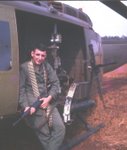
Original artwork by Joe Cline
Having an engine failure will point out how well you learned your emergency procedures in flight school and if you practiced them, mentally anyway.
Jimmy and I were on a C/A, (combat assault) one day and the third or fourth ship into the LZ. We had six grunts on board, were on short final at about 60 – 70 knots airspeed and simultaneously the low RPM beeper started it’s “teeeeep, teeeeep” and the master caution illuminated. Engine failure!
I had control of the aircraft at the time and Jimmy called the N-1 (or compressor turbine) RPM as “decaying” and that the engine / rotor tachometer had “split” which meant the engine had declutched automatically at the sprag clutch in the transmission. I had the collective pitch on the bottom, (but never remembered doing this consciously). Jimmy called the rotor RPM, airspeed and when we were clear of the trees at the edge of the LZ.
I pulled the nose up to bleed off the little airspeed we had left and applied the collective pitch to stop the descent. We settled on gently and slid about one aircraft length and the grunts exited. They didn’t even realize we had had an engine failure. The C and C, (command and control) aircraft called for us to clear the LZ and Jimmy responded that we couldn’t since we had lost our engine on final.
We tied down the blade and with the help of a couple grunts, established a defensive perimeter around the Huey. When the next bird unloaded their troops, we hopped on and returned to base camp with them.
It was all pure text book stuff with Jimmy and I reacting automatically and doing all the right things at the right time. The undamaged Huey was sling loaded back to Hensel by a Chinook; the engine changed and was back flying a couple days later. Maintenance told us the engine failure was caused by FOD, “foreign object damage” to the compressor section. The FOD was determined later to be several rounds, probably from an AK-47. This time, the maintenance officer and our CO got us drunk!



No comments:
Post a Comment